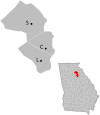Risky business in Georgia's wild birds: contact rates between wild birds and backyard chickens is influenced by supplemental feed
- PMID: 35508913
- PMCID: PMC9128352
- DOI: 10.1017/S0950268822000851
Risky business in Georgia's wild birds: contact rates between wild birds and backyard chickens is influenced by supplemental feed
Abstract
Backyard chickens are increasingly popular, and their husbandry varies widely. How backyard chickens are housed may influence the accessibility of chicken feed and water to wild birds, and thus, the contact rates between both groups. Increased contacts have implications for pathogen transmission; for instance, Newcastle disease virus or avian influenza virus may be transmitted to and from backyard chickens from contaminated water or feed. Given this potentially increased pathogen risk to wild birds and backyard chickens, we examined which wild bird species are likely to encounter backyard chickens and their resources. We performed a supplemental feeding experiment followed by observations at three sites associated with backyard chickens in North Georgia, USA. At each site, we identified the species of wild birds that: (a) shared habitat with the chickens, (b) had a higher frequency of detection relative to other species and (c) encountered the coops. We identified 14 wild bird species that entered the coops to consume supplemental feed and were considered high-risk for pathogen transmission. Our results provide evidence that contact between wild birds and backyard chickens is frequent and more common than previously believed, which has crucial epidemiological implications for wildlife managers and backyard chicken owners.
Keywords: Avian influenza virus; Newcastle disease virus; backyard chickens; contact rate; wild birds.
Conflict of interest statement
None.
Figures



References
-
- Elkhoraibi C et al. (2014) Backyard chickens in the United States: a survey of flock owners. Poultry Science 93, 2920–2931. - PubMed
-
- Vynnycky E and White RG (2010) An Introduction to Infectious Disease Modelling. New York: Oxford University Press.
-
- Garber L et al. (2007) Non-commercial poultry industries: surveys of backyard and gamefowl breeder flocks in the United States. Preventive Veterinary Medicine 80, 120–128. - PubMed
-
- Dorea FC et al. (2010) Survey of biosecurity protocols and practices adopted by growers on commercial poultry farms in Georgia, U. S. A. Avian Diseases 54, 1007–1015, 1009. - PubMed
Publication types
MeSH terms
Substances
LinkOut - more resources
Full Text Sources
Medical

